Quick Summary:
-
- 25th Ironman, 9th Kona Qualifying spot
- 9:39:57 (fifth-time going sub 9:40!)
- 3rd place in M40-44
- 8th Overall
- 2nd American
- Swim PR
The Preparation
My 2017 race schedule had already included, Ironman Mont Tremblant and Ironman World Championships, just four weeks prior to Ironman Los Cabos. With little time between the two races, I had to quickly get my mind and body back on track — Asking my Endurance Nation teammates what they suggest was task number one.
One of the most important things about having a team like Endurance Nation on your side is the 800+ different perspectives. The team itself is built to facilitate sharing and that collective knowledge becomes another tool for you to create the success that you seek.
No surprise, I got some incredible feedback from some of our most experienced members. The basic summary of their advice was this:
- Four weeks is not just “doable” to race again at a peak level, it’s actually ideal.
- I had to start training right away to get my blood plasma back up.
- I should really focus a ton on the swim not worry so much about the run.
To be 100% transparent, the fact that I didn’t run the entire marathon in Hawaii really helped to set me up for the race in Los Cabos. I swam hard, I biked hard, and I ran the first 10 miles in the heat at a very good clip (for me). But when my race blew up over the last 16 miles, I was forced to run with intermittent walking.
I was disappointed, but at the same time, I knew that I had an opportunity to do something more. Walking around the day after the race, I felt fine. No residual soreness whatsoever. To my body, Kona was little more than a taper for an extra long race rehearsal. Those last 16 miles of the marathon are what really make a difference not only in terms of your performance but also the impact on your body.
With this knowledge in mind, I quickly turned to my indoor training. In fact, after the World Championships, I only swam on my Vasa Ergometer, rode my Ventum One in my basement on Zwift, and ran on the treadmill (except for two runs outside). I think I finally have my pain cave set up and dialed in — the results are pretty powerful.
I never really thought about it before, but now that I’m using my indoor training so much it’s clear to me that a dollar spent on establishing your Pain Cave has much greater impact on your fitness and performance than a widget or thing that you would only use when racing. Don’t hold back this winter when you’re making your training set up the best it can be!
While there was some great advice on heat acclimation, there was only so much I could do. The main reason? The sheer amount of work around starting the Endurance Nation 2018 training season with our Run Durability Program for new Members and the 2018 OutSeason® training programs (Members Only through 12/31/2018). Rather than head to the sauna, I focused on my nutrition plan as well as using an indoor space heater to simulate hot conditions on the run.
I mentioned above that I was focused on getting my blood plasma back up. This was a new concept for me, and it came from (surprise!) one of my Endurance Nation teammates Rich Stanbaugh. Entitled “Detraining: The Truth About Losing Fitness” you can read starting in the Day Seven section the cost of extended detraining as related to your blood volume (between a 5% to 12% drop which means your heart has to work harder). Given that your sweat comes from your blood, such a drop can significantly reduce your race performance in a major endurance event.
The easiest way for me to achieve this was to do two back-to-back long rides as soon as I was able. Seven days after Kona I did an easy spin; eight days after was a 90-minute ride, and nine days after was a two-hour ride. A bit of recovery then set me up for the two key long rides — the first was four hours long, the other was 2.5 hours with some tempo.
This allows me to reverse the trend associated with detraining, and get my body back on track instead of sinking into maintenance mode. I pretty much did the same swims that I did into Kona to check on my benchmarks, and the runs were all done at a steady 7:45 to 8:00 per mile pace depending on the day.
The Destination: Los Cabos
I came to Los Cabos is because my good friend Jeffrey Capobianco from Breakthrough Performance Coaching had already planned it for the end of his season. Jeffrey had raced Ironman® Cozumel in 2016, so the late-season strategy seems to work out for him. With most of the logistics already done, it was pretty easy for me to follow in his footsteps.
I can’t say enough good things about this place. There is certainly some instability due to crime in this region, but the tourist area here was very well-maintained and accessible. I never felt in danger, although as a tapering triathlete I didn’t spend much time outside my hotel, partying, or wandering the streets at night.
The food here was simply amazing — I’m not sure I will ever eat steak again because there’s no way it can taste as good as they make it in Los Cabos. The location is beautiful the weather is stunningly similar every day. My understanding is that there will still be a 70.3 here for the next three years, and I strongly recommend you come to experience this course and this region.
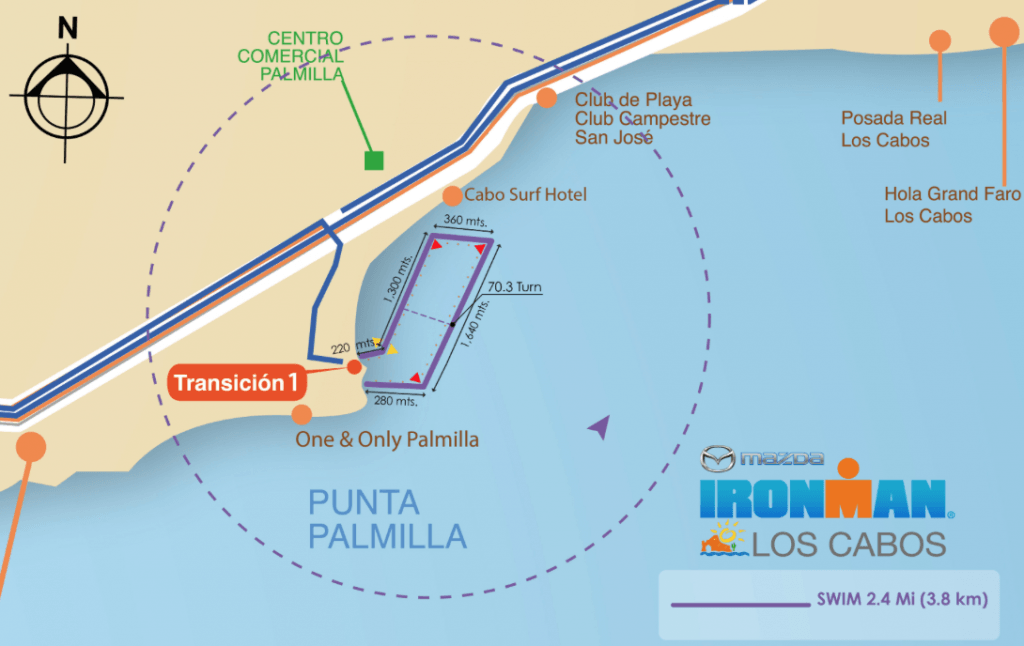
The Swim: 1:00:38 (14th AG)
Critical Decision: Higher Cadence
This is a beach start ocean swim with two athletes running in at a time. We swam straight out to the ocean for quarter-mile, turned left and swam a little more than a mile on the longest leg of the race. Another left turn brought us back to shore over quarter-mile before the final fourth leg head back to the swim exit which is on the opposite side of the peninsula where we started.
While the start area was not as wavy as it had been in our practice session, there were still some very good swells. My experience in Hawaii really set me up to handle this well and I had a good action plan in place.
I decided early on after my performance in Hawaii that a higher cadence was mandatory to be successful. I focused on this with my Vasa Ergometer workouts and as a result was able to maintain a very connected and engaged stroke. In fact, I found that the more I position myself in the water as I train on the Vasa, the stronger and better I feel. This is with a taut chest and a slightly lifted head.
That’s neither here nor there, but my strength in the water was clear allowing me to swim straighter than many other folks due to the swells and changing conditions.
Bonus that our partners at Roka equipped me with their Viper Pro Short Sleeve Swimskin. The hydrophobic properties of the swim skin and the super fit make sure I am as fast as possible on race day. Bonus that it covers the long sleeves of our custom Castelli Stealth Race top, setting me up for a great swim.
While the swells were coming in from our right at first, and then our left on the return trip, it was the chop from the wind and a few subtle currents that really messed with people. I had no such issues and really enjoyed the swim.
The Bike: 5:02:38 (2nd AG)
Critical Decision: It Is Not A Bike Race!
There were quite a few early changes I made in preparation for this bike. Once again I used the software from our friends at Best Bike Split to map out how I was going to handle the course. As a result, I knew before I even arrived here that the course was approximately 107 miles, and that there were two distinct climbs at either end as well as what my target watts should be.
What I was unprepared for were the challenges associated with riding along the coast in significant heat. There’s simply no substitute for riding the course before the race.
I had made some modifications to my nutrition plan as well once I heard that they would only be certainly serving regular Gatorade on the course. I went with a concentrated Gatorade Endurance feed bottle in my rear cage. This allowed me to fill up my front Profile Design bottle with water from each Aid Station and then simply add the appropriate dose of concentrate for consumption.
This ended up working out really well as the aid stations were actually quite short and left me a little time to grab anything more than two quick bottles. And the water was chilled while most of the Gatorade seemed to be warm.
Many aid stations were blocked by some of the slower 70.3 competitors looking for a break. This is where the drink reservoir on my Ventum One came in handy. I used this as a backup source of fluids — I drank more than half of the reserve and it has quickly become an important part of my nutritional success on the bike.
The big X-factor on the day was going to be the heat. The temperatures typically hit the low to mid-90s here, and race day was no exception with the temperature peeking around 92°F for a five-hour window.
And when the winds shifted to a tailwind, climbing any substantial hill was simply torture. Again, my experience racing in Hawaii prepared me mentally for what was going to come, but there was no way to offset the cost of competing in such conditions. At the very least, I knew that I was going to survive unlike perhaps many of the other riders out there!
The bike started off decently enough, with a steep climb up from the beach and then the tailwind out to the first climb at about mile 15. This is a fast section here and the first 5 miles of climbing up and out onto the course was a real eye-opener as to just how challenging the other climbs were going to be at the opposite ends of the course.
Road conditions were fairly challenging as there were quite a few unfinished sections, forcing the organizers to reroute us in several unique ways. At the end of the day, however, running 25 mm tires with latex tubes at about 85 PSI was perfect.
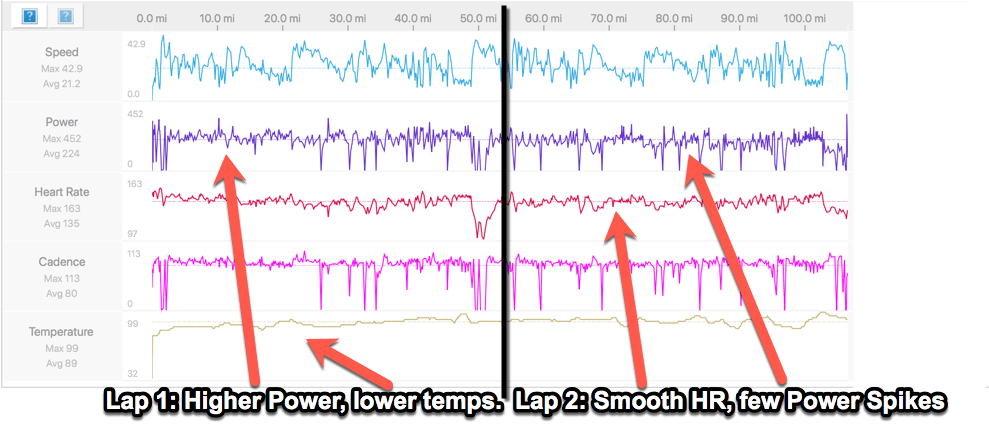
The most critical decision on the bike was backing things down for my second lap. After the first lap of following my power plan, it became quickly apparent that my Heart Rate was simply too elevated.
Inside Endurance Nation we recommend that you race with Power targets and a Heart Rate “cap” to prevent doing early damage to your race day goals. My Heart Rate Cap on the bike was 140 early, 145 for the second lap. By the time I had finished the first lap I had already spent significant time at 140 and just realized that a repeat of this performance of the second lap was not going to cut it.
I turned my power down significantly, telling myself “This is not a bike race!” When I got back to look at the data I noticed my second lap was lower according to my intensity factor. The first lap was completed at .75 (75% of my threshold power), but the second was a mere .66 (66%). Ironically enough, this change only meant losing 1/10th of a mile per hour (20.9 on lap one, 20.8 on lap two) — a positive split of just two minutes!
This is a good reminder that sometimes riding fast in the fast sections and smart on the harder sections can be more than sufficient.
The Run: 3:29:17 (2nd AG)
Critical Decision: Trust the Numbers!
Once again, the run was the most decisive part of the day. Of all three disciplines, in this particular race, I was most concerned about the run. I had no idea how my body would handle coming down from the World Championships. Nor did I know how it was going to face the heat.
My two test pre-race test runs with my Stryd Power Meter said my form was high and that the actual cost of running in the heat of Los Cabos was fairly low. The humidity is reasonable here and there is often a decent breeze off of the ocean. This really helps to mitigate the cost of the heat and gave me some good confidence heading into the day.
Coming out of Hawaii my plan was to do what I had not done there: to trust the metrics I saw as to how my body was handling the performance versus following the subjective feedback that my body was telling my brain. With power targets in mind, and a heart rate cap in hand, I got off the bike and went to work. Thanks to the new Ironman tracker, I knew right away that I was in fourth place (approximately four minutes down to third) with fifth place only two minutes behind me.

I was really feeling solid on my first lap. My power numbers were great and I ran through every aid station with purpose. I only really stopped at about 6 to 8 stations. The volunteers of these stations were teenagers and they were fantastic. Lots of energy and they made the day fun.
My critical decision on the run was to be in the moment. I often find myself drifting off from the present heading towards fictional thoughts of what might happen later in the run. They range from negative (“Is that a terrible cramp coming on???”) to the overly optimistic (“I am really going to crush that last lap”).
But neither thought is useful to me in the moment. The reality is, I can only handle what happens to me when it happens!
As you can see from the data image, things got pretty hard around Mile 15, but I was able to stay focused. My power dropped but my Heart Rate continued to build as I was keeping the pressure on. By the end of the run, I was actually catching up to the leaders of my Age Group finishing only a few minutes short by the end.
At the end of the day, I put up one of my best runs in my hottest race and walked away not only with Third Place in my Age Group but a renewed level of confidence in my fitness and ability to run in all conditions.
The Conclusion
With this qualification race behind me, I look forward to a more relaxed 2018. There are plenty of things that we have planned for Endurance Nation between training camps and trips, as well as the usual family events.
I will be competing in Kona in 2018, and plan to spend a good block of time getting ready for that in a strategic, yet not overwhelming way. This is the first time I’ve ever qualified for Kona with a year to go, and I am very aware that there are pluses and minuses to this approach. Regardless, I am both honored and humbled by the thought of this being my ninth trip to the Big Island to compete alongside the best in the world.
Many many thanks to my incredible family and my amazing wife for supporting me. To my friends who have guided me and encouraged me through every step of this journey, thank you. To my travel partner Rich Stanbaugh who not only gave me incredible information about the race but helped me make some decisions that paid off in spades…this race would not have been possible without you. To my Team, you are the best. What we have built here inside Endurance Nation is something both profound and powerful. There’s simply no way I could have been as strong or as confident without your input.
Okay, enough mushy stuff. It’s time to stop typing and to start eating!

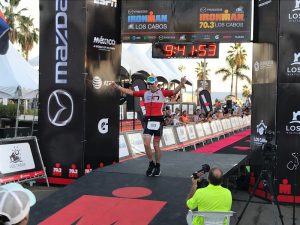

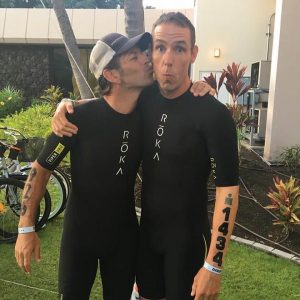
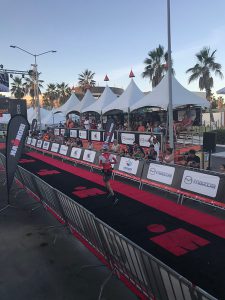
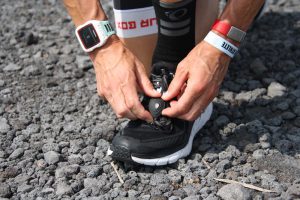
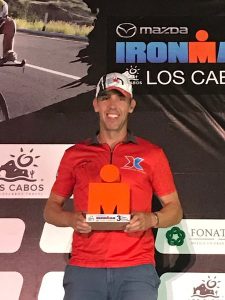

Leave a Reply